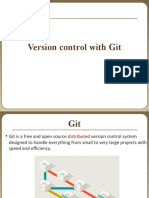0 ratings0% found this document useful (0 votes)
168 viewsProgramming Foundations Version Control With Git
Version control systems like Git allow developers to track changes to source code over time. Git is a distributed version control system that stores the entire history of a project locally, including all file versions and commits. Users interact with Git through either a graphical user interface or command line interface. Common commands include git add to stage files, git commit to save changes to the local repository, and git push to sync changes with a remote repository. Branching allows developers to work independently on different features before merging them together.
Uploaded by
Solution GuruCopyright
© © All Rights Reserved
Available Formats
Download as PDF, TXT or read online on Scribd
0 ratings0% found this document useful (0 votes)
168 viewsProgramming Foundations Version Control With Git
Version control systems like Git allow developers to track changes to source code over time. Git is a distributed version control system that stores the entire history of a project locally, including all file versions and commits. Users interact with Git through either a graphical user interface or command line interface. Common commands include git add to stage files, git commit to save changes to the local repository, and git push to sync changes with a remote repository. Branching allows developers to work independently on different features before merging them together.
Uploaded by
Solution GuruCopyright
© © All Rights Reserved
Available Formats
Download as PDF, TXT or read online on Scribd
You are on page 1/ 4
LinkedIn Learning
Programming Foundations: Version Control with Git
1. Version control systems are often used to manage the source
code for development projects so they are also sometimes
referred to as a _____.
source code manager
2. Why would using a hosting service for version control systems
(e.g. Bitbucket, Github) be more beneficial than a cloud service
(e.g. Dropbox, Google Drive)
VCS hosting services include extra features beyond just file
syncing such as issue tracking, collaborations tools and wikis.
3. Why are commits an essential part of using Git?
Commits are used to track the changes in a Git repository. The
version history consists of a series of commits.
4. How is a centralized VCS different from a distributed VCS?
Centralized: All project files and the version history must be
stored on a remote central server. Distributed: The entire
directory of project files and version history can be stored
locally or remotely.
5. Which type of VCS model does Git belong to?
Distributed Version Control
6. What is the difference between using a GUI and the command
line to perform different actions?
GUI: Uses icons, menus, buttons and other graphical
representations to perform actions. Command line: Uses text-
based commands to execute the action.
7. In computing, the operating system's interface is referred to as
the _____.
Shell
8. The working directory is where you _____. The staging area
stores the _____. The repository contains the _____, which
create the version history.
make edits; list of revisions; commits
9. When saving a file with Git, what two steps are required?
First add the file, then commit it.
10. When adding modified files to the repository, what
commands are used and in what order?
Use git add to move the modified files from your working
directory to the staging area. Then git commit the add the files
to the repo.
11. After creating a remote repository in your Git hosting
account, how do you create a local copy of the remote repo?
Use git clone with the remote repo URL.
12. Which of the following commands will set the username
for all your repositories.
git config --global user.name "Your Username"
13. In the command ls -a, what does the -a represent?
An argument, used to run different options such as listing all
files, including hidden files.
14. What is command used for creating a local Git repository?
git init
15. What are the two commands used to keep a local and
remote repository in sync and how are they used?
git push is used to upload the local commits into the remote
repository. git pull is used download the commits from the
remote repository, and merge the changes into the local
repository.
16. The git status command can be used to show:
A. what branch you're on
B. whether the local and remote repos have the same number of
commits
C. a list of modified and unmodified files
D. which files have been staged
A, B, D
17. Which command is used to navigate to different
directories?
Cd
18. If you delete the local repository, will the remote
repository be deleted as well?
FALSE
19. If you wanted to push the commits from your local master
branch to your remote master branch, what would the command
look like?
git push origin master
20. Which of the following is a benefit for using command
line over a GUI?
All Git commands can be executed using the command line.
With a GUI, the features will vary.
21. What does "checkout" mean in the context of using Git
branches?
To checkout a branch is to switch to that branch's working
directory.
22. How are the branches that you create different from the
default master branch?
Git makes no technical distinction between the master branch
and other branches.
23. When should a feature branch be merged into the
designated central branch (usually the master branch)?
Once the modified files have been tested, added, committed and
deemed ready to be included as part of the latest codebase.
24. When you make a commit in a branch, where is the
commit initially stored?
In the revision history of that branch.
25. When deleting a branch, what does "Force delete" mean?
The branch will be deleted, even if it hasn't been merged or has
outstanding commits that haven't been pushed.
You might also like
- 55106-Typescript Javascript's Superset Solution50% (12)55106-Typescript Javascript's Superset Solution4 pages
- 55106-Typescript Javascript's Superset Solution50% (12)55106-Typescript Javascript's Superset Solution4 pages
- Popular Git Interview Questions and AnswersNo ratings yetPopular Git Interview Questions and Answers5 pages
- Version Control - Subjective Interview Questions_documentNo ratings yetVersion Control - Subjective Interview Questions_document11 pages
- GIT Tips/ Interview Questions & Answers: Here Are Some Basic Git Commands. Hope This Will Help YouNo ratings yetGIT Tips/ Interview Questions & Answers: Here Are Some Basic Git Commands. Hope This Will Help You2 pages
- CSE 390 "Lecture 11": Version Control With GitNo ratings yetCSE 390 "Lecture 11": Version Control With Git23 pages
- 1.2_ Git Basics _ Environment Variables (2201)-Class (2)No ratings yet1.2_ Git Basics _ Environment Variables (2201)-Class (2)23 pages
- Top 50 Git Interview Questions and Answers (2024) - GeeksforGeeksNo ratings yetTop 50 Git Interview Questions and Answers (2024) - GeeksforGeeks18 pages
- GitHub Foundations Exam Prep: 500 Practice Questions with Detailed ExplanationsFrom EverandGitHub Foundations Exam Prep: 500 Practice Questions with Detailed ExplanationsNo ratings yet
- Utmjl11 Scajc1 1: Semester Parts Subject Code Subject Name Hours Per Six Working Days CreditsNo ratings yetUtmjl11 Scajc1 1: Semester Parts Subject Code Subject Name Hours Per Six Working Days Credits4 pages
- The Ultimate Introductory Guide Harmy's Star Wars Trilogy Despecialized EditionsNo ratings yetThe Ultimate Introductory Guide Harmy's Star Wars Trilogy Despecialized Editions1 page
- .JSP Extension Are The File Name Homepage - JSP: JSP & JDB Lab Manual For IT by Abdo .A at W K U (2 0 1 7)No ratings yet.JSP Extension Are The File Name Homepage - JSP: JSP & JDB Lab Manual For IT by Abdo .A at W K U (2 0 1 7)6 pages
- SMS Playstation 2 Simple Media System Manual PDFNo ratings yetSMS Playstation 2 Simple Media System Manual PDF76 pages
- APCSP Lesson - Binary To Decimal ConversionNo ratings yetAPCSP Lesson - Binary To Decimal Conversion16 pages
- Microsoft Word: Syllabus of ICT For First Term (48 CTP)No ratings yetMicrosoft Word: Syllabus of ICT For First Term (48 CTP)4 pages
- Complete Download (Ebook) Information Technology in a Global Society - Glossary by Stuart Gray ISBN 9781468023619, 1468023616 PDF All Chapters100% (1)Complete Download (Ebook) Information Technology in a Global Society - Glossary by Stuart Gray ISBN 9781468023619, 1468023616 PDF All Chapters63 pages
- Kubuntu - Installation - KDE UserBase WikiNo ratings yetKubuntu - Installation - KDE UserBase Wiki8 pages































































































